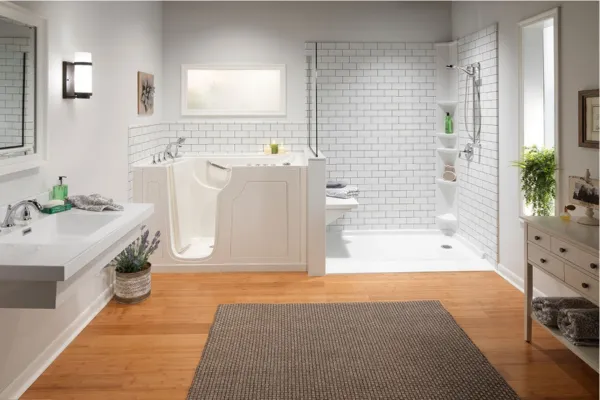MVP services all of Southwest Ohio, from Dayton, Cincinnati, and Columbus...to every pocket in between!
MVP’s Blog: Your Guide To A Better Bathroom Experience

Walk-In Showers vs. Walk-In Tubs: Which Is Right for You?
When it comes to bathroom renovations, the choice between a walk-in shower and a walk-in tub can be daunting. Both options offer unique advantages, but the right choice largely depends on your specific needs, preferences, and bathroom layout. This article will delve into the key differences between walk-in showers and walk-in tubs, helping you make an informed decision that enhances both the functionality and aesthetic appeal of your bathroom.
Understanding the Basics: Walk-In Showers vs. Walk-In Tubs
A walk-in shower is designed for easy access, typically featuring an open entrance or a low curb. It's ideal for those who prefer a quick, invigorating shower and can be customized with various fixtures, such as rain showerheads, body jets, and seating. Walk-in showers often create a spacious, modern look in a bathroom, making them popular in contemporary home designs.
On the other hand, a walk-in tub is a deep bathtub with a door, allowing users to step in without having to lift their legs over a high edge. Walk-in tubs are particularly beneficial for individuals with mobility issues, as they offer a safer bathing experience. Many walk-in tubs also come equipped with therapeutic features like hydrotherapy jets and heated surfaces, providing a spa-like experience at home.
Safety Considerations: Prioritizing Accessibility and Comfort
Safety is a primary concern when choosing between a walk-in shower and a walk-in tub. Walk-in tubs are specifically designed with safety in mind, featuring grab bars, anti-slip surfaces, and built-in seating. These features reduce the risk of slips and falls, making them an excellent choice for seniors or individuals with limited mobility.
Walk-in showers can also be equipped with safety features such as grab bars, non-slip tiles, and seating options. However, they require careful planning to ensure that these elements are properly integrated. For families with elderly members or those with disabilities, the decision may lean toward a walk-in tub due to its comprehensive safety features.
Space Requirements: Maximizing Your Bathroom Layout
The amount of space available in your bathroom is another crucial factor to consider. Walk-in showers are generally more space-efficient, especially in smaller bathrooms. They can be installed in corners or alcoves, and their open design can make a bathroom feel larger and more open. Walk-in showers also offer more flexibility in terms of design, with options like glass enclosures, tiled walls, and custom fixtures.
Walk-in tubs, while larger than standard bathtubs, require more floor space. They are best suited for bathrooms with enough room to accommodate their size. If your bathroom is compact, a walk-in shower might be the more practical option. However, if you have the space and value the therapeutic benefits of a soak, a walk-in tub could be worth the investment.
Installation and Maintenance: What to Expect
When it comes to installation, walk-in showers generally have a more straightforward process. Depending on the design, they can be installed relatively quickly and with minimal disruption. Maintenance for walk-in showers typically involves regular cleaning of the glass, tiles, and fixtures to prevent mold and mildew.
Walk-in tubs require a more complex installation process due to their size and the plumbing modifications needed. The installation may take longer and involve more significant alterations to your bathroom. Maintenance for walk-in tubs includes regular cleaning of the tub and the door seals to ensure they remain watertight. Some walk-in tubs also require periodic checks of the hydrotherapy systems to keep them functioning optimally.
Cost Comparison: Evaluating Your Budget
Budget is often a deciding factor in the walk-in showers vs. walk-in tubs debate. Walk-in showers tend to be less expensive than walk-in tubs, both in terms of initial purchase price and installation costs. The cost can vary depending on the materials, fixtures, and customization options you choose.
Walk-in tubs, particularly those with advanced features like hydrotherapy jets and quick-drain systems, can be more costly. However, they offer long-term benefits, especially for those who plan to age in place. Investing in a walk-in tub can add value to your home and provide peace of mind for individuals who prioritize safety and accessibility.
Lifestyle Preferences: Customizing Your Bathing Experience
Your lifestyle and personal preferences should play a significant role in your decision. If you prefer quick showers and want to maximize your morning routine, a walk-in shower is likely the better choice. Walk-in showers are also ideal for active households where multiple people need to use the bathroom quickly.
If you enjoy long, relaxing baths and seek a therapeutic experience, a walk-in tub may be more suitable. The deep soak and the potential for hydrotherapy can provide relief for sore muscles, arthritis, and other ailments. For those who view their bathroom as a sanctuary for relaxation, the walk-in tub offers unparalleled comfort.
Environmental Considerations: Water Usage and Energy Efficiency
Environmental impact is another factor to consider. Walk-in showers typically use less water than walk-in tubs, especially if you opt for water-saving showerheads. This can result in lower water bills and a reduced environmental footprint.
Walk-in tubs require more water per use, which can lead to higher utility costs and increased water consumption. However, some walk-in tubs are designed with efficiency in mind, featuring quick-drain systems and water recirculation options to mitigate these concerns. If sustainability is a priority, you may want to explore eco-friendly features in both walk-in showers and tubs.
Making the Final Decision: Which Is Right for You?
Choosing between a walk-in shower and a walk-in tub ultimately depends on your individual needs, the layout of your bathroom, and your budget. If safety and accessibility are your top concerns, particularly for aging in place, a walk-in tub might be the best option. However, if you prefer a modern, space-efficient design that accommodates a busy lifestyle, a walk-in shower could be the ideal choice.
Consider how each option aligns with your daily routine, long-term plans, and overall bathroom design. Both walk-in showers and walk-in tubs offer distinct advantages, and with the right planning, either can transform your bathroom into a functional and luxurious space.
FAQs
What are the main differences between a walk-in shower and a walk-in tub?
Walk-in showers offer quick, convenient access and are often more space-efficient, while walk-in tubs provide a safer, more therapeutic bathing experience, especially for those with mobility issues.
Which is safer for seniors, a walk-in shower or a walk-in tub?
A walk-in tub is generally safer for seniors due to features like grab bars, anti-slip surfaces, and built-in seating, which reduce the risk of falls.
Can a walk-in shower be made as safe as a walk-in tub?
Yes, walk-in showers can be equipped with safety features such as grab bars, non-slip flooring, and seating, but they may still require careful design to ensure they are as safe as a walk-in tub.
How do the costs of installing a walk-in shower compare to a walk-in tub?
Walk-in showers typically cost less to install than walk-in tubs. Walk-in tubs, especially those with advanced features, can be more expensive due to the additional plumbing and installation requirements.
Is a walk-in tub worth the investment for aging in place?
Yes, a walk-in tub can be a valuable investment for aging in place, offering enhanced safety, comfort, and therapeutic benefits that can improve quality of life.
Which option is better for small bathrooms, a walk-in shower or a walk-in tub?
Walk-in showers are usually better for small bathrooms due to their space-saving design. They can be installed in tight spaces and make the room feel more open.




Alexandria
Amelia
Anderson
Arcanum
Batavia
Beavercreek
Bellbrook
Bexley
Blacklick
Blue Ash
Bridgetown
Brookville
Canal Winchester
Centerville
Cheviot
Clayton
Cleves
Deer Park
Delhi
Dublin
Eaton
Englewood
Fairfield
Forest Park
Fort Thomas
Franklin
Germantown
Gahanna
Grandview Heights
Grove City
Groveport
Hamilton
Harrison
Hilliard
Huber Heights
Independence
Johnstown
Kenwood
Kettering
Lewis Center
Loveland
Madeira
Mariemont
Mason
Miamisburg
Millford
Montgomery
Moraine
Mount Healthy
New Albany
New Carlisle
Norwood
Oakwood
Pataskala
Pickerington
Plain City
Powell
Reading
Reynoldsburg
Riverside
Sharonville
Springboro
Springdale
Sunbury
Taylor Mill
Tipp City
Trotwood
Upper Arlington
Vandalia
West Carrollton
Westerville
Whitehall
Worthington
Wyoming
Xenia
FINANCING AVAILABLE
18 MONTHS
0% INTEREST
FOR ALL WALK-IN TUBS, SHOWERS, & BATHROOM REMODELING PROJECTS.
PHONE NUMBER: (937)-897-9974
ADDRESS: 2601 S DIXIE DR, DAYTON, OH 45409
HOURS: MONDAY-FRIDAY, 9AM-6PM
EMAIL: [email protected]
FACEBOOK: MVP WALK-IN TUB AND SHOWER
INSTAGRAM: MVP WALK-IN TUB AND SHOWER



